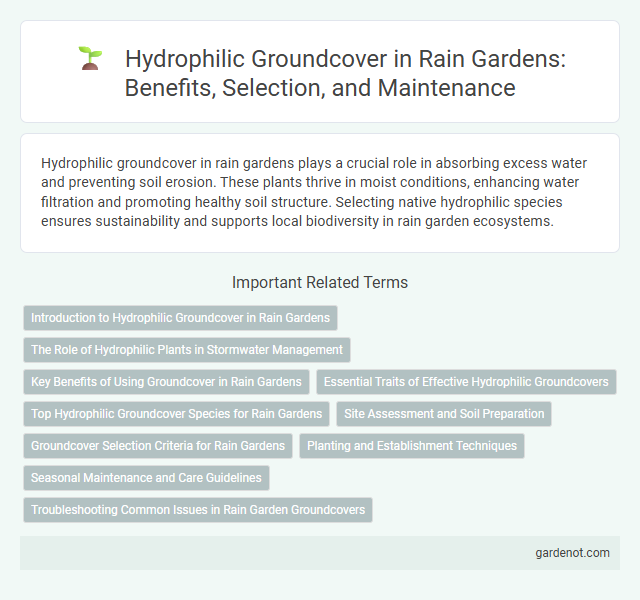Hydrophilic groundcover in rain gardens plays a crucial role in absorbing excess water and preventing soil erosion. These plants thrive in moist conditions, enhancing water filtration and promoting healthy soil structure. Selecting native hydrophilic species ensures sustainability and supports local biodiversity in rain garden ecosystems.
Introduction to Hydrophilic Groundcover in Rain Gardens
Hydrophilic groundcovers in rain gardens are specially adapted plants that thrive in consistently moist or wet soil conditions, enhancing water absorption and reducing runoff. These plants improve soil stability, filter pollutants, and support local biodiversity by providing habitat for aquatic and terrestrial species. Selecting hydrophilic groundcovers such as sedges, rushes, and native wetland grasses optimizes rain garden performance and promotes sustainable stormwater management.
The Role of Hydrophilic Plants in Stormwater Management
Hydrophilic groundcover plays a crucial role in stormwater management by enhancing water absorption and reducing runoff volume in rain gardens. These moisture-loving plants improve soil permeability and promote the uptake of excess water, minimizing erosion and pollutant transport. Incorporating species such as Carex, Juncus, and Lobelia ensures effective filtration and sustains the ecosystem's hydrological balance.
Key Benefits of Using Groundcover in Rain Gardens
Hydrophilic groundcover in rain gardens enhances water absorption and reduces surface runoff, promoting effective stormwater management. These plants stabilize soil, preventing erosion while filtering pollutants and improving water quality. Their extensive root systems support soil health and provide habitat for beneficial microorganisms, increasing the ecological resilience of rain garden ecosystems.
Essential Traits of Effective Hydrophilic Groundcovers
Effective hydrophilic groundcovers exhibit high water absorption capacity, enabling efficient rainwater infiltration and soil moisture retention. Their deep root systems enhance soil stability and prevent erosion in rain garden environments. These plants also demonstrate resilience to fluctuating moisture levels, thriving in both saturated and dry conditions typical of rain garden cycles.
Top Hydrophilic Groundcover Species for Rain Gardens
Top hydrophilic groundcover species for rain gardens include Blue Flag Iris (Iris versicolor), Creeping Jenny (Lysimachia nummularia), and Marsh Marigold (Caltha palustris), each known for their high water tolerance and soil stabilization properties. These plants thrive in saturated conditions, effectively filtering runoff while preventing erosion and supporting local biodiversity. Selecting native species such as Pennsylvania Sedge (Carex pensylvanica) further enhances rain garden functionality through deep root systems that improve soil infiltration rates.
Site Assessment and Soil Preparation
Hydrophilic groundcovers thrive in rain gardens due to their ability to absorb and filter stormwater effectively, reducing runoff and enhancing soil moisture retention. Conducting a thorough site assessment, including soil texture, infiltration rate, and existing vegetation, ensures the selection of appropriate hydrophilic species suited to the garden's microclimate and hydrology. Proper soil preparation involves amending compacted or nutrient-poor soils with organic matter to improve porosity and water-holding capacity, creating optimal conditions for root development and pollutant removal.
Groundcover Selection Criteria for Rain Gardens
Hydrophilic groundcovers for rain gardens must exhibit tolerance to periodic flooding and saturated soil conditions to ensure plant survival and effective water absorption. Groundcover selection criteria include species with strong root systems to prevent soil erosion, native plants to support local ecosystems, and varieties with moderate growth rates that balance coverage without overwhelming the garden space. Optimal groundcovers, such as Carex and Juncus species, enhance pollutant filtration while providing habitat for beneficial insects and maintaining aesthetic appeal throughout wet and dry cycles.
Planting and Establishment Techniques
Hydrophilic groundcovers thrive in rain gardens by absorbing and filtering stormwater efficiently, enhancing soil moisture retention. Effective planting techniques include spacing plants according to their mature size and ensuring root zones are well-prepared with organic mulch to promote healthy establishment. Consistent watering during the initial growth phase helps groundcovers adapt and develop resilience to fluctuating moisture conditions common in rain garden environments.
Seasonal Maintenance and Care Guidelines
Hydrophilic groundcovers in rain gardens require seasonal maintenance to ensure optimal water absorption and soil stabilization. During spring and fall, remove debris and dead foliage to promote healthy growth and prevent fungal diseases. Regularly monitor soil moisture levels and trim overgrown plants to maintain efficient water filtration and aesthetic appeal.
Troubleshooting Common Issues in Rain Garden Groundcovers
Hydrophilic groundcovers in rain gardens often face issues such as poor drainage, leading to root rot and plant stress. Ensuring soil composition is well-draining with a mix of sand and organic matter helps mitigate waterlogging problems. Regular monitoring for pests and adjusting water flow can prevent common groundcover decline and maintain healthy growth.
Hydrophilic groundcover Infographic

 gardenot.com
gardenot.com